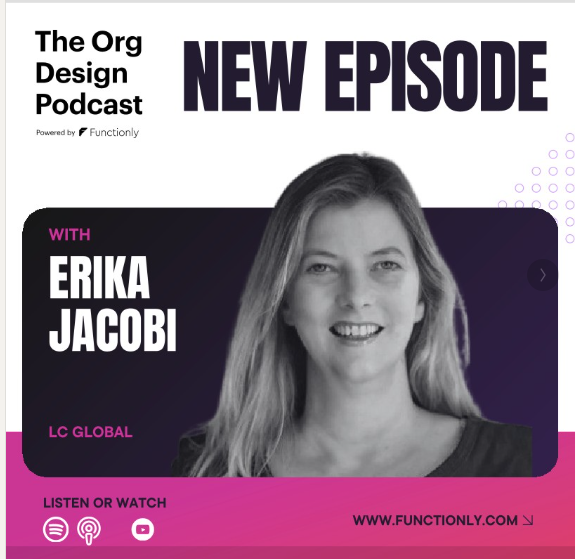Artificial intelligence is no longer a tool exclusively used to execute predefined tasks. In many organizations, it has become an active participant in shaping how work gets done—and increasingly, how organizations themselves are designed. The transformation is unfolding quietly and unevenly, but its direction is clear: As AI becomes more agentic—autonomous, proactive, and self-learning—it begins to mediate the very structures through which work, collaboration, and capability evolve.
LC GLOBAL® - Organization Design & Development Consulting
Recent Posts
How Agentic AI Can Shape Your Organization Design
Topics: Organization Desgin, Adaptive Organization Design, AI, OrgDesign, Agentic AI
Navigating Uneven Progress in Organization Design
In adaptive organization design, the broader destination is often clear. Our clients typically set out to build flatter structures, foster stronger collaboration, and create the conditions for adaptability and engagement. Yet while the goals may be well defined, the path to reaching them rarely unfolds in a straight line. The development pace of people, processes, and workflows differs widely, and the granular end state is never fully visible at the beginning. What unfolds instead is a journey where even the underlying processes, skill sets, and workflows continue to emerge throughout the transformation. Along the way, unexpected challenges surface. Departments progress at uneven speeds, leaders lag behind teams, and skepticism from employees lingers longer than anticipated. For clients and stakeholders alike, it is crucial to recognize that these challenges are not flaws in the process. They are inherent to collaborative approaches that embrace co-creation and shared ownership. In other words, they are part of the process—and without working through them, meaningful change cannot occur. In this article, we explore the most common forms of uneven progress and what it takes to navigate them effectively.
Topics: Leadership, Organization Desgin, Adaptive Organization Design, OrgDesign
Structure Drives Behavior: Dr. Erika Jacobi on the OrgDesign Podcast
At LC GLOBAL®, we are proud to share that our very own Dr. Erika Jacobi, Founder and Executive Director, was recently invited to join The Org Design Podcast, hosted by Amy Springer and Damian Bramanis and powered by Functionly. This podcast brings together thought leaders and practitioners who are reshaping how organizations are designed to meet the challenges of today’s fast-changing environment. In this special episode, Dr. Jacobi explores why structure drives behavior and how thoughtful design can help organizations adapt, grow, and thrive. The full conversation is available to watch further down in this article—but first, we want to highlight some of the key insights she shared and what they mean for leaders navigating transformation today.
Topics: Leadership, Organization Desgin, Adaptive Organization Design, OrgDesign
Organization Design: Ready or Not
"Ready or not, we’re going to launch next month." This phrase often circulates from management during periods of structural change and tends to mark the starting point of confusion, disruption, and resistance. In later assessments of legacy issues, the same reflection is often echoed from leaders and team members alike: "They told us, 'Ready or not,' and we were absolutely not ready." It's not always a story of complete failure — but one of missed signals, misaligned actions, and the long shadow of a rushed, pressured launch.
Topics: Organization Desgin, Change Readiness, Assessment, OrgDesign
Organization Design: Dealing with the Unexamined Organization
Socrates famously declared that "an unexamined life is not worth living." His words remind us that self-reflection is not a luxury, but a necessity for personal growth, integrity, and transformation. At each stage of our lives, pausing to take stock of our beliefs, behaviors, patterns, and priorities allows us to live with greater purpose and authenticity. Without such examination, we risk remaining stuck in outdated mindsets or routines, drifting away from what truly matters, and missing opportunities for alignment and evolution. Growth, after all, is not a spontaneous outcome but a process fueled by awareness, choice, and action.
Topics: Organization Desgin, Assessment, OrgDesign
Organization Design Without Knowing the Full Picture
During explosive growth or times of uncertainty, organizational leaders often face a critical dilemma: They’re expected to make important organization design decisions at a moment when clarity is missing. Many hold off, waiting for more data, a finalized strategy, or a shift to settle. But by the time that information arrives, the ground has already shifted.
Topics: Organization Desgin, Organizational Decision-Making, OrgDesign
Hidden Assumptions that Make or Break Your Organization Design
Most organization design efforts begin with a clear goal—one that promises greater agility, efficiency, and engagement. Leaders invest significant time in defining new structures, roles, and workflows. Yet, months later, many find themselves wondering: Why isn’t the new design delivering the expected results? The answer often lies not in the design itself, but in the assumptions behind it.
Topics: Organization Desgin, Adaptability, Organizational Decision-Making, OrgDesign
Integrated, Proactive Decision-Making: A Cornerstone of Adaptability
In adaptive organization design, we don’t just structure for efficiency, such as by removing bottlenecks or redundancies. We design to shape leadership behaviors, system interactions, and team dynamics to prevent reactive cycles and instead enable prompt, sound, and proactive decision-making.
Topics: Adaptability, Organizational Decision-Making, OrgDesign
Organization Design for Competition and Disruption Readiness
This week’s DeepSeek incident sent shockwaves through global markets wiping out over 1 trillion in market value in a single day. The Chinese AI startup’s sudden rise—offering an alternative to existing AI models—led to a steep selloff in major tech stocks, including a historic $593 billion drop in Nvidia’s market cap alone. While this sounds like a once in a life-time event, the reality is: It's part of a very normal "faster, cheaper, better" innovation cylce. The sheer speed of brutal competition and disruption raises an essential question: Is your organization designed to embrace competition and stay ahead of disruption?
Topics: Organization Design, Business Innovation, disruptive change, Disruptive Innovation, Adaptability, OrgDesign
Zombie Structures: Legacy Challenges in Organizational Transformations
When organizations transition to flatter structures, they often aspire to empower teams, foster collaboration, and enable agile decision-making. Yet, one of the most common challenges we encounter when we are being called into an organization is the persistence of "zombie structures." These are legacy habits, processes, and behaviors that refuse to stay buried, undermining the transformation effort.
Topics: Organization Design, Business Innovation, Adaptability, OrgDesign



















